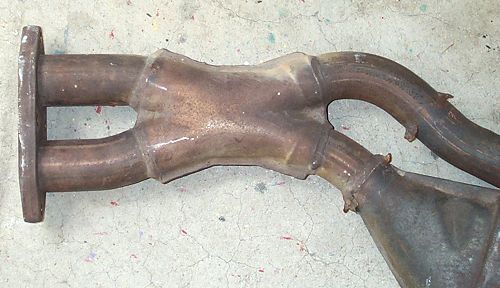|
|
| In recent years it has become common to hear people speak of the "X-Pipe" when they discuss the S14 factory exhaust. To many E30 M3 owners, the X-Pipe has become a familiar item. Once you get a good look at an X-Pipe it's clear what it is. But other owners may not be familiar with the X-Pipe concept. Either they are new owners, and have never heard of an X-Pipe. Or they have not had a chance to see it, since the only time the X-Pipe is visible is when the car is in the air and you are underneath it. For clarification an S14 factory X-Pipe is shown in the photo below: |

|
|
The next logical question is; "What does an X-Pipe do?" It has been born out through trial and error, as well as dyno testing, that removing the X-Pipe from the exhaust results in a loss of torque and HP. This is because the X-Pipe forms a vital part of the S14 exhaust pressure wave tuning. A detailed explanation of this phenomena will not be given here, but the theory is that as individual exhaust pulses move down the exhaust tract, they leave behind them a negative pressure wake. If the exhaust pathways come together at just the right places, then these negative pressure wakes can help "suck" on neighboring cylinders in such a way that those cylinders achieve much higher filling then they would on their own. Some articles state that the suction on the intake tract due to proper exhaust tuning can be as much as 500% greater than the suction caused by the piston moving down in the bore. This sheds light on the importance of proper exhaust pressure wave tuning. It is possible to cause a cylinder to draw in a greater amount of air/fuel than would be indicated by it's volume alone. |

|
|
"Interference" based exhaust pressure wave tuning is what leads to the familiar "Tri-Y" header design often used on four cylinder engines. What the S14 X-Pipe does is form the final junction on a Tri-Y header. The only difference is that instead of one pipe coming out of the "Y", there are two (at least in stock configuration). Thus there is an "X" at the end of the secondaries instead of a "Y" (an "H-Pipe", a.k.a. "cross-over" could also be used although it is unclear if it would be exactly as effective). In each case the purpose is the same. The fact that the E30 M3 has two exhaust pipes running out to the back of the car from the X-Pipe is probably more in the interest of ground clearance and sound quality than for performance. Once you are past the "interference pressure wave tuned" part of the exhaust, then you simply want to get the gases out as efficiently and quietly as possible. So both a single or a double tube arrangement can be made to work after the Tri-Y section. The following photo show a typical Tri-Y header design (in this case for a Miata): |
 The green arrow shows the last "Y" junction, where the E30 M3 has an X-Pipe. The yellow
line highlights the area where on an E30 M3 there is an interface between the header and the
center section (usually the catalytic converter section). But this interface does not change the
overall design. The fact that the S14 does not have a continuous header all the way past the X-Pipe
(the last "Y") is merely incidental. The blue arrow shows the location of the first two "Y's" where
the primary pipes join the secondary pipes. This is identical to the S14 arrangement,
which is displayed below:
The green arrow shows the last "Y" junction, where the E30 M3 has an X-Pipe. The yellow
line highlights the area where on an E30 M3 there is an interface between the header and the
center section (usually the catalytic converter section). But this interface does not change the
overall design. The fact that the S14 does not have a continuous header all the way past the X-Pipe
(the last "Y") is merely incidental. The blue arrow shows the location of the first two "Y's" where
the primary pipes join the secondary pipes. This is identical to the S14 arrangement,
which is displayed below:
|

|
| This is a Jet hot coated Evo III (a.k.a. 2.5L Gr A) header mated to a custom Burns Stainless Y-Pipe. The principle is the same as for an X-Pipe, the junction where the secondary tubes come together is the last of the three "interference" pressure wave tuned sections. After this point the exhaust gases are best directed to the exit through a minimum flow resistance path (usually one or two straight through mufflers). If the mufflers are straight through, and there is no "pressure wave termination box" then there will be one last negative reflection from the tailpipe. Thus the overall length of the exhaust system, from exhaust port to tailpipe, is important. |

|
|
The picture above shows where BMW chose to "squish" the double exhaust pipes where they pass under the rear subframe. This was obviously done in the interest of ground clearance, since this is the lowest point of the exhaust system. However, the tubes are distorted quite a bit - a rough calculation by Jim Butterworth showed that the cross-sectional area is decreased by approximately 12%. This has a significant effect on flow resistance. Conclusion: if you are not obsessed with ground clearance, then removing this restriction offers scope to increase the performance of the factory exhaust layout. |
|
Go to: Details of the Factory Exhaust Center Section |
|
|